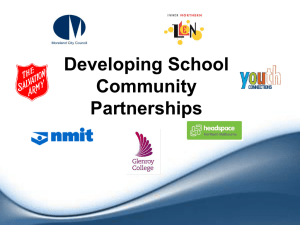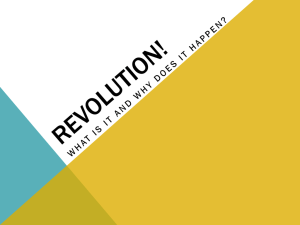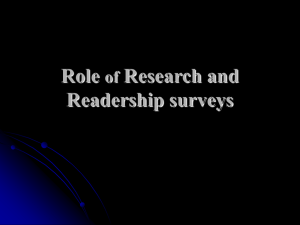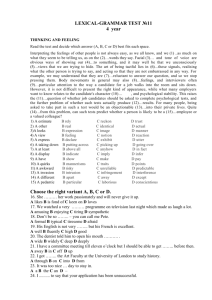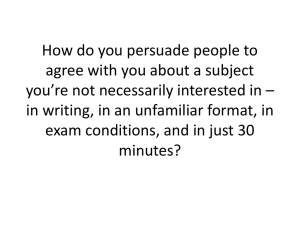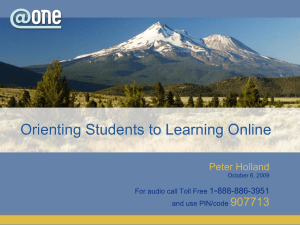Barriers and Enablers to the Wider Adoption of e-Infrastructure e-Uptake project team
advertisement
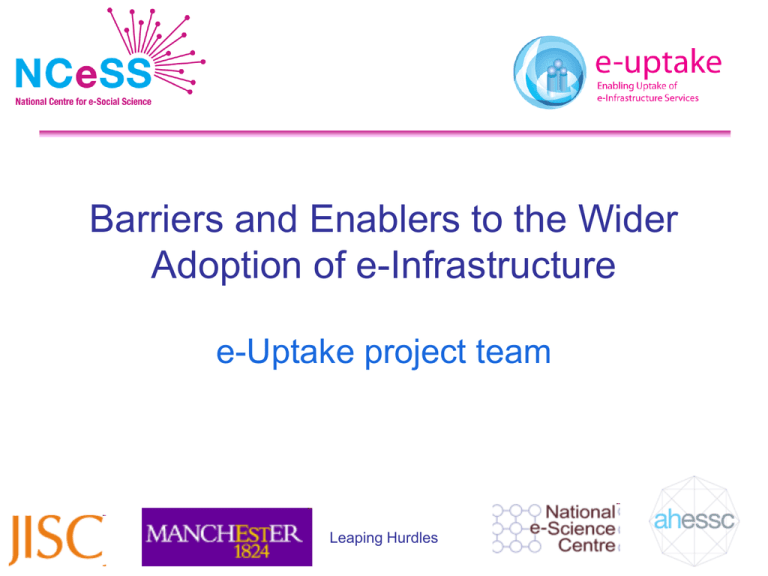
Barriers and Enablers to the Wider Adoption of e-Infrastructure e-Uptake project team Leaping Hurdles e-Uptake Overview Led by National Centre for e-Social Science in collaboration with the National e-Science Centre and Arts & Humanities e-Science Support Centre. Aim to provide evidence base for targeted interventions and strategic planning which will enable widening uptake of eInfrastructure across all disciplines. Leaping Hurdles 2 Approach Develop a broad empirical basis for understanding barriers and enablers for adoption of e-Infrastructure: look beyond isolated, contingent or random problems identify recurring, widespread barriers that can be overcome by targeted interventions and longer term planning Leaping Hurdles 3 Data Gathering Phase 1: 50 interviews with researchers drawn from across the main disciplines. Phase 2: 50 interviews with ‘intermediaries’ in HEI IT services: mix of established, ‘aspirational’ HEIs and small, specialist research institutions aimed to have 2 interviewees per institution: one at strategic level one with direct user support role All interviews recorded, transcribed and coded for analysis. Leaping Hurdles 4 Phase I Interviews Leaping Hurdles 5 Phase II Interviews HEIs chosen on basis of THES 2007/08 ranking HEFC funding Research awards Research applications Leaping Hurdles 6 Analysis Transcripts coded up using a typology developed from literature review and subsequently evolved in light of emerging findings. Online database of findings to allow stakeholders to browse or search corpus of findings. Data represented in XML format to allow automatic processing and easy transformation into different presentation formats. Leaping Hurdles 7 Typology of Barriers Typology used to analyse findings and to facilitate browsing. Based on literature review. Iterative refinement in the light of data. Leaping Hurdles 8 Database of Findings Title Description Examples from Fieldwork Enablers Leaping Hurdles Explore online at: http://cnx.org/content/m20185/latest/ 10 Stages in the Research Tools Lifecycle Configuration Leaping Hurdles 12 Barrier: Lack of Awareness Lack of systematic introduction to the services and the training available. Support and outreach activities varied significantly between different kinds of institutions and between different disciplines. Awareness of services provided within an institution is systematically reported to be higher than that of equivalent services provided elsewhere even if those have a national remit. “The big problem we face is people write their proposals, run into problems, come to us, but in their proposal [nothing] was mentioned about computing or visualisation.” Leaping Hurdles 13 Enabler: Awareness Raising Leaping Hurdles 14 Enabler: Roadshows “[…] So I would suggest a sort of travelling roadshow – give presentations, go round different universities, you know, show them what’s available, show them how it could be useful.” (Researcher) Leaping Hurdles 15 Enabler: Exemplars “Having stuff where you can show that people have done really new science using those tools […] it seems to be working quite well in terms of getting engagement and we're seeing that other communities just like these things – like the systems biology communities are beginning to be very keen to play and join in.” Leaping Hurdles 16 Barrier: Assessing Costs of Adoption “I can see that there are things there which we probably could be able to use in the future but first we’d have to work out how. There are projects, for example, like OGSA-DAI and OGSA-DAI has some features which I can see they would be useful if we had skills or if we had the time to actually be able to get far enough into the technology to be able to actually utilise it properly.” (Researcher) “It was very difficult in the early days for me to see what Grid could do for me kind of thing, and therefore […] It’s getting a lot better now, but initially there was, for a very selected community, large scale facilities and problems and it wasn’t really for me and it was quite difficult to get over that barrier.” (Researcher) “So you’re working with products that come out of research rather than out of a software factory, […] it's difficult to decipher what the risk is before you start.” (e-Science Centre) Leaping Hurdles 17 Enabler: Support for Exploring Possibilities “I can see that there are things there which we probably could be able to use in the future but first we’d have to work out how.” (Researcher) “[...] it would be good to have some pilot funding to really spend some time with […] to run a pilot experiment to see when there are problems [that] could be addressed by some of the […] tools.” (Researcher) Leaping Hurdles 18 Barrier: Technical Complexity “[...] grid computing [...] is an under-utilised resource. I think there probably are barriers to people understanding how they could use it, what they could do with it […] but I’d imagine that there’s a lack of understanding of the technical context.” (IT services) “Other projects – not necessarily medical ones, but also engineering ones – where the organisations involved saw the Grid as [a] great looking solution but didn’t want their data to leave their network […]” (Researcher) Leaping Hurdles 19 Enabler: Training Short courses: Introduction to e-Research, data management, campus Grids, Access Grid, web services, etc. Academic courses: Well-developed undergraduate and postgraduate curricula, and (foundational) courses. Training support: Shared t-Infrastructure for running training and educational exercises, etc. IPR framework to allow for sharing of educational/training materials. Leaping Hurdles 21 Barrier: Lack of Common Ground “I’m not an e-Scientist and it’s one of the things that’s sort of continually frustrating in the field is the assumed terminology if you know what I mean? There’s a lot of terminology that’s come over from computing science which is never designed for the rest of us who actually do the science […]” (Researcher) “It is hard though because people talk different languages and you’ve got to learn to understand each other’s languages and what different people are doing. And see how they can merge together.” (IT Services) “There’s a general need for more training that’s aimed at the domain experts rather than e-Science experts.” (Researcher) Leaping Hurdles 22 Enabler: Greater User Engagement “Maybe now [IT services] need to get back and think about helping people with what it is they want to use computers for.” (Researcher) “IT services has […] academic liaison directors whose task it is to speak to the users and their colleges. [There are] monthly stakeholder meetings, and [liaison staff] go out and meet with the research groups.” (IT services) “There is a need for more people to sit down with scientists and work with them on their specific applications […] people that understand both applications and also understand how to gridenable them.”(Researcher) “[…] we had to do the focus groups and it meant that we could be closely involved with all these people coming in and saying what were the barriers to them using a national data service, but it was the contact with the users that was great.” (IT services) Leaping Hurdles 23 Barrier: Lack of Wider Integration In an e-Research world, support infrastructure has to be fit for purpose everywhere. “[…] we had hoped when Access Grid started that it would develop and become something that we could have on our desktop, in fact we use it much less now. We use Access Grid only with those that we know there is a very good support, so it’s wonderful for our collaboration with […] and […] but all of those centres have very good support […]” (Researcher) Leaping Hurdles 24 Enabler: Re-alignment of Support Infrastructure Support services must devise business models that are acceptable to users and which ensure that the services they offer are sustainable. “I think the [AG] node here, there was an attempt to try and make it pay for itself or make it generate money, and people stopped using it and therefore the service was very sketchy but we were still quite reliant on it.” (Researcher) Support services (both local, regional and national) must work more closely together to share their expertise, raise standards and establish common practices and policies. “It is important that JISC explain to the community what facilities there are, so that we can share that with our users.” (IT Services) Leaping Hurdles 25 Enabler: One-Stop Shop Closing gaps between stages of engagement through a more effective support infrastructure. Configuration cf. EGEE Virtuous Cycle Leaping Hurdles 27 Summary e-Infrastructure is often seen by its users (both current and potential) as complex and challenging: Current users experience frustrations, potential users are unaware of its benefits and how to take the first steps Support services and knowledge networks often fail to provide access to the right information and advice: Closer collaboration between local support services and users for a better understanding of requirements and what is possible Greater of integration between service providers at the national level and support services at the local level We must create around the technical infrastructure a social infrastructure that is coordinated nationally but grounded in a local presence that makes it pervasive and accessible. cf CIR Strategy report http://wikis.nesc.ac.uk/escienvoy/Century_of_Information_Research_Strategy Leaping Hurdles 28 e-Uptake Project Team NCeSS: Rob Procter, Alex Voss, Marzieh AsgariTarghi, Peter Halfpenny. NeSC: David Fergusson, Elizabeth van der Meer, Malcolm Atkinson. AHeSSC: Elpiniki Fragkouli, Stuart Dunn, Sheila Anderson, Lorna Hughes. Leaping Hurdles 30
